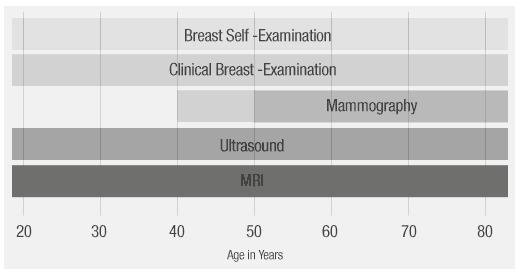About Breast Cancer
Breast cancer is the most common cancer among women and increasingly common in the Western world. One in eight women will contract breast cancer before the age of 85 years. (In 2006 it is estimated 13,200 Australian women will contract the disease.) [1]
Global Position
The incidence of breast cancer varies dramatically between geographic regions. Genetic differences among populations, variations in lifestyles, environmental exposures and medical practices such as screening are likely to be important determinants of cancer risk [2].
Breast Cancer and Ageing
The biggest single risk factor in developing breast cancer is getting older.
Around 75% of all breast cancers occur in women aged over 50 years.
However whilst the incidence of developing breast cancer is less common in younger women, when it does occur the tumour is often larger and more aggressive.
There is no routine screening program for women under 40 years.
Breast Cancer Screening & Diagnostic Options

There are limitations surrounding current breast cancer screening methodologies, and no detection method is 100% accurate. Therefore, a program utilising a combination of tests will provide the optimal detection at any age.
Early Detection
Bio Farmag believes in early detection and recommends that a program of continual breast care should be part of woman's life from the age of 20 years. An annual Bio Farmag Test when available could be included as a part of a regular testing regime, and should be supplemented with regular self-checking and clinical examination.
Mammography is not routinely performed on women under 50 years of age due to their breast tissue being too dense for an accurate reading.
The Australian Government breast screening program targets the age group of 50-69 years where the evidence is that screening has the greatest potential to prevent mortality from breast cancer. BreastScreen Australia reports that around 800,000 mammograms are conducted each year. The recent study “Breast Cancer in Australia: an overview 2006” indicated the participation rate of females aged 50-69 years has decreased to only 56%.
The report also noted in 2004-5 a further 173,000 mammographies and other radiographic breast examinations were privately billed to Medicare for symptomatic males and females.
Diagnosis
Currently, breast self-examination, clinical examination, mammography, magnetic resonance imaging (MRI) and ultrasound are the main methods used to detect a breast mass/lump. If a suspicious breast mass is detected, it is biopsied to rule out or confirm a diagnosis of breast cancer.
Beginning at the age of 20, medical practitioners recommend that every woman begin a routine program of breast health, including practising monthly breast self examination and scheduling annual physician-performed clinical breast examinations. Beginning at the age of 50, women are actively encouraged to have regular screening mammograms, in addition to regular clinical breast examinations, and practice breast self-examination.
Mammography is the current gold standard for mass screening of breast cancer.
Mammograms are not recommended for younger women because their breast tissue is dense, making it more difficult to detect changes. Ultrasound may be most helpful in women with high breast density. Generally, breasts become less dense as women get older, particularly after menopause.
References
[1] Australian Institute of Health And Welfare and NBCC Cancer series 34.
[2] Rastogi T, Hildeshei m A, Sinha R. Opportunities for Cancer Epidemiology in Developing Countries. Nat Rev Cancer 4 (11): 909-917, 2004.
[3] Parkin D.M. et al. Cancer Incidence in the Five Continents VIII. IARA Scientific Publication No. 155 IARC Press, Lyon, France, 2002
